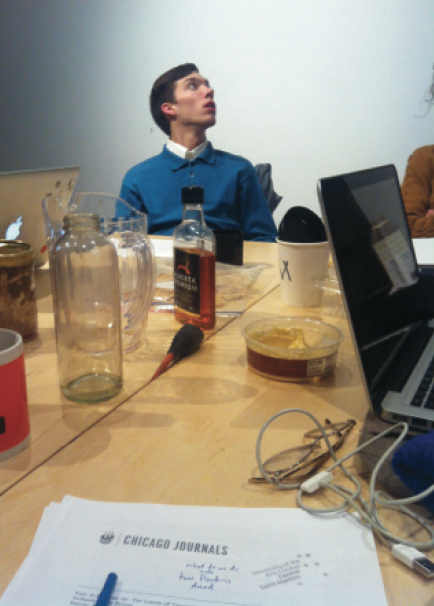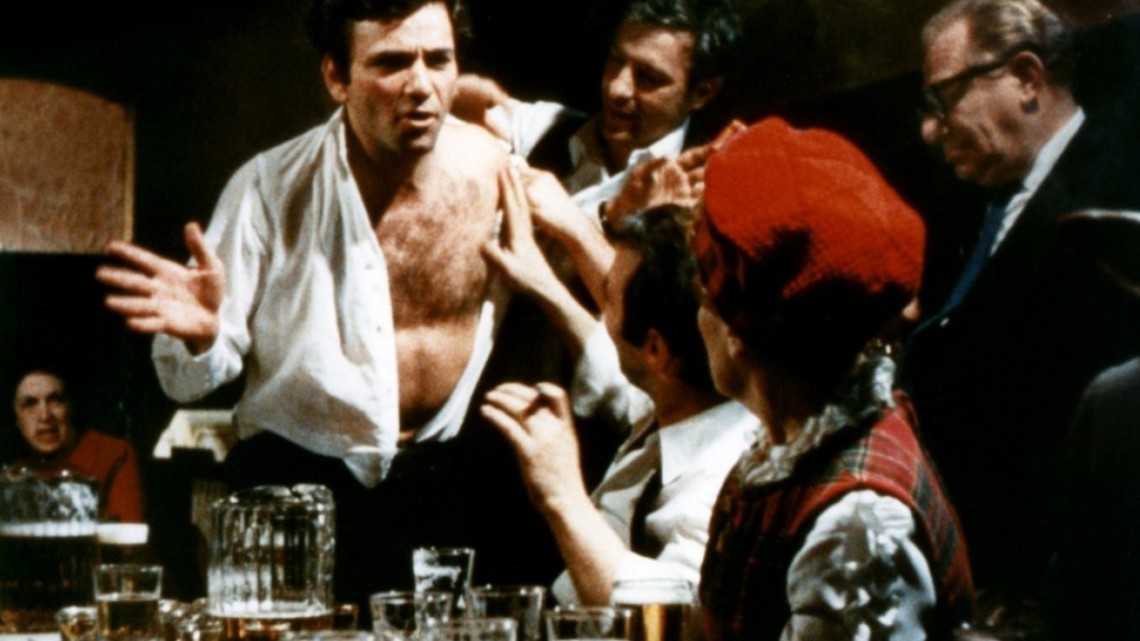At the end of my undergrad, I realized that I can’t do anything by myself. I don’t like to do things by myself; I don’t strive for solitude. I began to think that my optimism and friendliness could not lead to true art, but rather happiness. I had no hope as an artist at all. I liked people, for the most part—a bleak asset if I wanted to create something that would transcend as much as human suffering itself! My happiness doesn’t mean anything. It’s not poetic, or interesting, or critical, to like people. And then, suddenly, it was.
What was it exactly that I was not doing on my own? In the midst of the collaborative turn, I was making art after all. All my work had an element of conversation, or had presented dialogue in an overt way. My final project was called Chatting (2013) because it embodied, as a metaphor, most of my time at school—a daily production, a slow-cooked edification, and an embrace of quotidian potential. Not only could I not do anything by myself, I didn’t ever shut the fuck up. I loved how natural it was to feel productive and part of something by virtue of sharing fairly untested words and notions that then turned into maybe-alright artworks. Though I still had the utmost respect for aesthetic value, this process was, to me, sufficiently “art.”
However, when I left art school, I passively resisted or declined a number of invitations to join book clubs, reading groups and collectives. There was something vaguely suspicious about getting together under the pretense of learning from each other, and disavowing the potential (or my romanticism?) of a de-professionalized, unstructured existence. I opted for the autodidacticism of my regular life—eating, drinking, smoking, going to the movies. Joining a reading group sounded like a constipated environment where everyone sits with their engaged-face on, listening for their turn to pontificate. “Let’s go,” they said, but they didn’t move. My initial response to pseudo-official peer-to-peer models of youthful posturing seemed a counterintuitive engagement after graduating from an institution. Collectives were more appealing, but no one seemed to have the organizational skills (only the oratory skills) to get any projects, or movements, off the ground. And naturally, life kept getting in the way. I realized that what I considered art when I was in school, was just leading a regular good life. And now that I wasn’t in school, I wasn’t making art—I was just eating and having interesting conversations with people, as the relatively happy person that I am. I considered spending more time alone OR taking up a serious social practice. But because there is no system of forked roads where one leads down the path to making art that abides by your true principles, I started to write, perhaps because writing is as close as it gets to talking all of the time, while making something of potential, tangible, cultural worth.
Artists must believe that what they’re doing is of utmost importance and meaning; this they know, and so they develop the instinct that anything to the contrary is a threat to more than just themselves, but the health of all intellectual and artistically driven forces in the world today. But people are usually getting in the way, invading your mind and timetable with invitations to parties and performances, or their unapologetic opinions. For Jonathan Franzen, “I used to consider it apocalyptically worrisome that Americans watch a lot of TV and don’t read much Henry James.” Self-imposed solitude is not only a bomb shelter, it’s soundproof—so you can’t hear the bombs go off. As a novelist writing in an accelerated age of technology, Franzen distinguished “silent heroes” from “gregarious traitors” and wrote that “the writer for whom the printed word is paramount is ipso facto, an untelevisable personality.” He goes on to emphasize the anti-social prerequisites—“The essence of fiction is solitary work: the work of writing, the work of reading . . . the social-isolate readers are more likely to become writers . . . reticence is integral to artistic creed.” It makes perfect sense that all these passages are quoted from his essay “Why Bother?” (1996) in a collection called How To Be Alone (2003).
In her brilliantly thorough book on the history and current conditions of collaborative and participatory art, Artificial Hells (2012), Claire Bishop illustrates the present moral compass of the art world, and it is the complete inverse of Franzen’s silence and gregarity binary. This compass points away from “bad” singular authorship and towards “good” collective authorship.1 The neurotic lone-wolf-self-interested, narcissistic, brooding and caustic, replaced with good hosts and event planners—generous, energetic, vulnerable and imaginative. Bishop identifies one of the main problems with the reception of collaborative, or participatory art, which is that process surpasses all results, or lack thereof. She writes, “The urgency of this social task has led to a situation in which socially collaborative practices are all perceived to be equally important artistic gestures of resistance: there can be no failed, unsuccessful, unresolved, or boring works of participatory art, because all are equally essential to the task of repairing the social bond”.2
But the collaborative turn is also an ethical turn, a social turn, so I can’t just throw raves and dinner parties, or open the door for someone, and consider it a collaborative artwork because it doesn’t “channel art’s symbolic capital towards constructive social change”.3 Although, if you throw a dinner party for your friends, and nobody sees it, did you throw a dinner party at all? There is an obvious answer. But according to the logic of social practice, the answer would be not really, but if you did have an audience, does that somehow make it irrefutably worthwhile and artistic? Not necessarily, but what’s left over in the wake of elusive processing is not exactly artistic, but instead preoccupied with disruption and wake-up calls dialed not into humanity itself, but the sleepy ethics of the contemporary art world, making many of these operations very radical by comparison to plastic arts.
People really do need respite, not from people, but from prattle, from the dispassionate justification of socializing-on-display as an art of the utmost worthy pursuit: to assemble and reassemble under the pretense of edification, and no one even gets fed, or paid. It gives socializing a bad name, at a time when the status of loneliness, as a valid condition for creative production, is more tenuous than ever.

No Monologue artist Dustin Brons leading a reading of Lane Relyea’s Your Art World: Or, The Limits of Connectivity, 2015. Photograph by Steffanie Ling.
But the impetus for art usually has something to do with people—to position myself in order to live with, or without them. More specifically, to vacillate between whether I want to live among them, or against them. Better to ask, “With and against whom?” Certainly not everyone, on either side of the question. To make art, must we then find people with mutual desires?
In an interview with Jessica Loudis titled “Should I Go To Grad School?”, Sheila Heti said that her post-graduate education came from attending and hosting events, and developing “intimacies” or something closer to love—“Instead of having sex, we have art.”4 There is a inescapably saccharine quality in listening to people talk about having a social life as anything more elevated than satisfying a basic human desire, but what is truly being emphasized is what avant-garde history is built upon: coterie. In other texts, Heti espouses it like a moral occupation. In her 2006 lecture Why Go Out? at Trampoline Hall, she unpacks this question by comparing what she identifies as two habitual masochisms: socializing and smoking. She describes her attempt to quit people, the way she quit cigarettes—“The longing for a person is almost identical to the longing for a smoke. It’s weird.”5
She puts a great deal of tension at the threshold of your apartment door, between whether we really believe in “silent heroes” or solitary geniuses or if we should answer the call to have a few drinks, and if something beyond that will be an experience that gives way to connecting with humans better, the way we really want to but won’t admit, because a part of us still believes in the solitary genius thing. So when we do (believe in the myth that is) we opt to stay in—“We could be like little Buddhas, meditating and masturbating and watching TV. And we could imagine ourselves to be brilliant, and kind, and good lecturers, and good listeners, and utterly loving—and there’d be no way to prove it otherwise”6 (my italics).
In the text, she also describes something to the effect of participatory art. Her friend had organized a charades workshop, where one’s listening skills, and ultimately, their people skills are surreptitiously tested. She writes, “I’ve come to the conclusion that what my friend is trying to do is organize events that capture and crystallize and reproduce the effects of ordinary socializing—which is not quite about fun, or about learning how to be good at having fun, but, more distinctly,” and discretely, “about learning how to be good at being a person.” 7
Heti’s texts often have questions for titles: Should I Go to Grad School?, Why Go Out?, and of course her novel, How Should a Person Be? And evidently, she doesn’t ever answer them alone (“I am not a stoic”) though she is the author. Whereas, in contemporary art, what Bishop describes as social practice seems be how many have elected to “prove” it. In this light, going out to prove what kind of person you are is “gregarious” indeed.
For Franzen, to write is to be alone, to talk to yourself, and for Heti, it is to be alone with the hope or intention of talking to someone else from the past, or future, because of it. I’ve used writers to talk about a phenomenon in the art world, because there is a limit to collaborating in text, how it can be communicated on the page, in writing, no guaranteed audiences, no potential participants. Yet, writers can opt to observe, stay in, or not bother, be passive spectators, pariahs of the participatory art paradigm. And chiding them for it would be ridiculous. Art should never be the proof of a critical consciousness, it is because of critical consciousness that we strive against loneliness, that Franzen facetiously asks “why bother?” and then writes a five-thousand word essay.
After a meal with a friend who had been abroad for three months, the bill did not come separated. Somehow, the notion of asking the server to return with two separate checks was anathema to the spirit of our reunion. I was responsible for 75% of the bill—I had already said the appetizer was my treat, and in addition to my own meal had ordered some takeout. To detail the separation, this, this and this, are mine, and this and this was hers is disturbingly menial, and when I imagined that taking place, I saw my life slipping away. I saw myself dying, the server dying, my friend dying. In these moments, it feels quietly melodramatic, when we are delegating what’s mine and yours, we are flirting with death more than smoking a cigarette after a feast of carbohydrates and chocolate. I think I continue going out in pursuit of enlightenment mired in friendship and generosity, towards figuring out how and with whom I want to live, when I need to be alone and who feels right to collaborate with.
From loneliness to collaboration, I ended up re-reading Cassavetes on Cassavetes (2001), a printed essay that was brought to my attention while curating a group exhibition, which, at its core, prompted the artists to question or evaluate their collaborative impulses.8 In the text, the director John Cassavetes writes plainly about how he works with actors: “I just think that you give somebody something they can do, and allow them to be a person.” Cassavetes gave his actors the option to do nothing, and reassured them that the consequence of their inaction wouldn’t be held against them, and would be accepted by him, and by the film, with gratitude for their naturalness, “Anyone can sit down and have a drink in a natural way if you don’t force them to do things they don’t really feel . . . what is needed between actor and director is a mutual understanding of human problems.” It begs the question, why should I participate? (a version of Heti’s question on going out) Rarely has my question been satisfied. I don’t even know you. What is my participation worth to you? Your cultural validation at the cost of my complicity and agreement that your gestures represent a critique of society is hardly a democratic exchange. It’s not people or reading groups that I’ve recoiled from, but rather the institutionalization of sincerity, and the vilification of our right to effective detachment. As a delicate ecosystem of a cast and crew, participation, collaboration, and socializing are needed to function and produce, but are not the congratulatory outcomes of the film itself. While art demands participation, film, an industry that seems to be constructed on “Action!”, can embrace the delivery of candor. Marlon Brando is quoted as saying, “Just because they say ‘Action’, doesn’t mean you have to do anything” (while in life he slugged paparazzi and chased after them with broken bottle in hand).9
“What we’re working on is not a house or anything tangible. It’s just something you see up on a screen. And it disappears in a second. And it’s only an opinion if you think it’s good or not. You must charge the atmosphere constantly, and you must do it honestly,” in this sense, Cassavetes’s idea of “charging the atmosphere” means that, as an actor, performing a role means being able to access your unadorned self.



